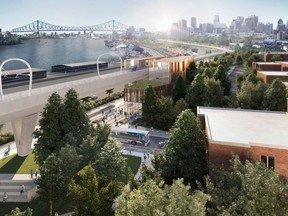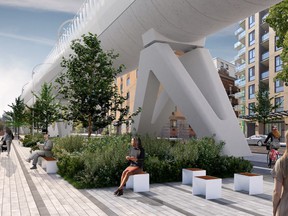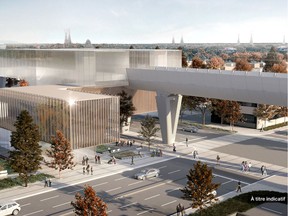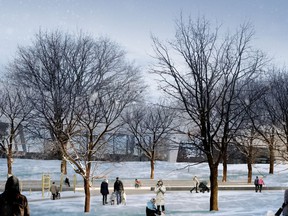Responding to criticism, planners of the REM de l’Est, ‘respectfully disagree.’

Article content
It will still be made out of concrete, and it will still be elevated through part of the downtown core, but planners of the proposed REM de l’Est say they believe they have made changes to the proposed network that the public will like.
advertisement 2
Article content
New renderings made public on Wednesday show a redesigned elevated rail that would be smaller, rounder and incorporate more design elements to allow it to better fit into the urban landscape. The concrete would also be lighter in colour. Pillars would be built on angles to “break up the monotony.”
The changes were made after the Caisse de dépôt et placement du Québec faced a barrage of criticism about a possible second phase of its Réseau Express Métropolitain — a driverless light-train network already under construction in the West Island, South Shore and North Shore, to be inaugurated in phases starting this year.

Proposed in December, 2020, the possible second act of the REM story would see a $10-billion light-rail network built on elevated rails over 32 kilometres, with 23 stations built between the downtown core and the city’s east end, with another branch to be buried under Lacordaire Blvd. to Montreal North. However, the concept has been panned by urban planners and other experts for its potential to create an urban scar in the downtown core.
advertisement 3
Article content
In response to the criticism, CDPQ Infra — the Caisse subsidiary in charge of the project — has offered to bury part of the network downtown, and expand the proposed tunnel at Lacordaire Blvd. so it remains underground until Montreal North. CDPQ Infra has altered its route in the Mercier East district to address fears the network would desecrate Sherbrooke St. E. A committee of independent experts was also set up to prepare a report about the project. Wednesday’s redesign is a response by CDPQ Infra to the report by those experts.
Speaking to the Montreal Gazette on Tuesday, Harout Chitilian, CDPQ Infra’s vice-president, corporate affairs, development and strategy, said not only will the proposed REM look nice, but it will provide the city with an opportunity to remake its downtown core into an inviting space for transit users, cyclists and pedestrians — with the potential of adding 16 kilometers of protected bicycle lanes.
advertisement 4
Article content

The rendered images show a remade René-Lévesque Blvd. that would have reduced car lanes, while there would be a protected bicycle path and pedestrian walkway next to the elevated rails. The space where the train would exit its tunnel just west of Chinatown would become a public park, with wheelchair access, allowing people to climb a small hill to a lookout showing the city’s downtown as well as the new automated train. There would also be public squares built around the stations.
“Imagine yourselves in 2030,” Chitilian said showing a rendering of the corner of a redesigned René-Lévesque Blvd. at St-Hubert St. “You’ll have completely redesigned street with active transport component, new public spaces and a public transit system , and four lanes dedicated to car usage (down from eight now). It will be an opportunity to rebalance the way public space is used.”
advertisement 5
Article content
Chitilian added that the cost of redesigning René-Lévesque Blvd. would have to be borne by the city and province, and said there are no cost estimates yet on such a project. However, he said initial discussions with the city have been fruitful.
Chitilian also took the opportunity to address other criticisms of the project, namely the choice of concrete for the elevated structures, and the potential to harm, rather than enhance existing transit networks.
He said concrete was chosen over steel because of its malleability, the ability to assemble its parts off-site, and the potential to clean off graffiti.

He also addressed criticism by the Autorité régionale de transport métropolitain, saying the network would convert far more car drivers to transit than the authority has estimated.
“We tend to respectfully disagree with the numbers the ARTM put forward. We think it will result in a (17 per cent modal shift to transit),” he said, adding that the REM de l’Est will also alleviate congestion on the Green Line and Orange Line of the métro, “which were at or near capacity before the pandemic began.”
Chitilian said taken with together with the REM currently under construction, both projects would add 100 kilometers of light rail to the region.
“Then we really have a connected city and metropolitan area end to end,” he said.